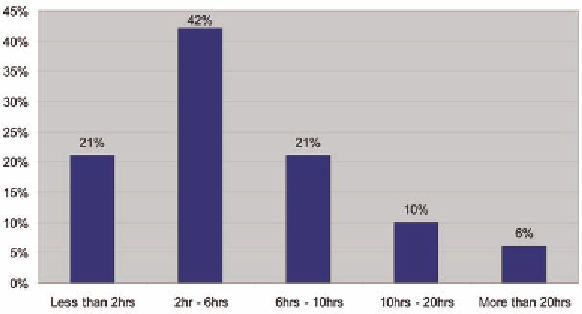Information Technology Reference
In-Depth Information
large-scale audiences. This high-level network
structure indicates that social networks are likely
to offer a suitable medium through which to ini-
tiate and deliver WOM communications.
Heinz
et al
(2005) observes that online social
network users display a low sensitivity to pri-
vacy, and exhibit a propensity to sharing a large
amount of information about themselves to both
friends and even strangers. Complimentary to
this observation, 70% of respondents admitted to
revealing their personal information (such as age,
telephone number and their relationship status)
on their profile.
Additionally, a large percentage (41%) of re-
spondents admitted to spending between two and
six hours on a social network per week. Figure
3 further reveals that 21% of respondents spent
between six and ten hours and 16% spent more
than ten hours interacting on a social network
each week.
When questioned as to whether they discuss
brands or products with each other, 80% of re-
spondents specified that they do. This suggests
that online environments are indeed an appropri-
ate (and potentially credible) medium through
which to stimulate WOM.
The survey also asked respondents which social
networks they were aware of, as well as which
networks they actually subscribed to.
Figure 4 reveals that two thirds of the re-
spondents were aware of Facebook, MySpace,
YouTube and Mxit, listed in descending order of
awareness. Blog0it, Mig33, Friendster and Xanga
were considerably less well known.
As per Figure 5, Facebook was revealed to be
the strong preference of social networking site.
Nearly eighty percent of respondents were regis-
tered Facebook users. MySpace, YouTube and
Mxit had minimal usage (none over thirty percent)
with the remainder having experiencing very
little usage. This confirms the popularity of Face-
book, over and above the competition, in South
Africa.
Characteristics and Motivations of
Social Networkers
Motivation occurs when a consumer strives to
satisfy a need that has arisen. The term 'need' es-
sentially refers to something that is either physical
or psychological that the individual must have in
order to function and develop (Cant
et al
, 2006).
Needs can be either innate or acquired. Innate
needs are physiological and help to sustain biologi-
cal life, while acquired needs are those learned in
response to an individual's culture and environ-
ment. In a marketing context, needs on their own
are not sufficient: the consumer must express the
Figure 3. Number of hours spent social networking per week

Search WWH ::

Custom Search